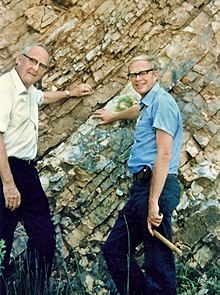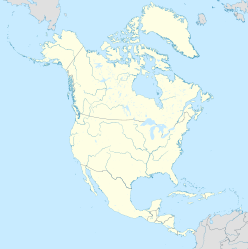Cretaceous–Paleogene boundary


The Cretaceous–Paleogene (K–Pg) boundary, formerly known as the Cretaceous–Tertiary (K–T) boundary,
The K–Pg boundary is associated with the Cretaceous–Paleogene extinction event, a mass extinction which destroyed a majority of the world's Mesozoic species, including all dinosaurs except for birds.[4]
Strong evidence exists that the extinction coincided with a large meteorite impact at the Chicxulub crater and the generally accepted scientific theory is that this impact triggered the extinction event.
The word "Cretaceous" is derived from the Latin "creta" (chalk). It is abbreviated K (as in "K–Pg boundary") for its German translation "Kreide" (chalk).[5]
Proposed causes
Chicxulub crater
| Chicxulub crater | |
|---|---|
| Chicxulub impact structure | |
Ma Cretaceous–Paleogene boundary[7] | |
| Exposed | No |
| Drilled | Yes |
| Bolide type | Carbonaceous chondrite |
| Location | |
| Coordinates | 21°24′0″N 89°31′0″W / 21.40000°N 89.51667°W |
| Country | |
| State | Yucatán |

In 1980, a team of researchers led by Nobel prize-winning physicist
When it was originally proposed, one issue with the "Alvarez hypothesis" (as it came to be known) was that no documented crater matched the event. This was not a lethal blow to the theory; while the crater resulting from the impact would have been larger than 250 km (160 mi) in diameter, Earth's geological processes hide or destroy craters over time.[9]
The Chicxulub crater is an
The crater is estimated to be over 150 km (93 mi) in diameter
The crater was discovered by Antonio Camargo and Glen Penfield,
In 2016, a scientific drilling project drilled deep into the
The shape and location of the crater indicate further causes of devastation in addition to the dust cloud. The asteroid landed right on the coast and would have caused gigantic tsunamis, for which evidence has been found all around the coast of the Caribbean and eastern United States—marine sand in locations which were then inland, and vegetation debris and terrestrial rocks in marine sediments dated to the time of the impact.[16][17]
The asteroid landed in a bed of
Deccan Traps
Before 2000, arguments that the Deccan Traps flood basalts caused the extinction were usually linked to the view that the extinction was gradual, as the flood basalt events were thought to have started around 68 Ma and lasted for over 2 million years. However, there is evidence that two thirds of the Deccan Traps were created within 1 million years about 65.5 Ma, so these eruptions would have caused a fairly rapid extinction, possibly a period of thousands of years, but still a longer period than what would be expected from a single impact event.[20][21]
The Deccan Traps could have caused extinction through several mechanisms, including the release of dust and sulfuric aerosols into the air which might have blocked sunlight and thereby reduced photosynthesis in plants. In addition, Deccan Trap volcanism might have resulted in carbon dioxide emissions which would have increased the greenhouse effect when the dust and aerosols cleared from the atmosphere.[21]
In the years when the Deccan Traps theory was linked to a slower extinction, Luis Alvarez (who died in 1988) replied that paleontologists were being misled by sparse data. While his assertion was not initially well-received, later intensive field studies of fossil beds lent weight to his claim. Eventually, most paleontologists began to accept the idea that the mass extinctions at the end of the Cretaceous were largely or at least partly due to a massive Earth impact. However, even Walter Alvarez has acknowledged that there were other major changes on Earth even before the impact, such as a drop in sea level and massive volcanic eruptions that produced the Indian Deccan Traps, and these may have contributed to the extinctions.[22]
Multiple impact event
Several other craters also appear to have been formed about the time of the K–Pg boundary. This suggests the possibility of nearly simultaneous multiple impacts, perhaps from a fragmented asteroidal object, similar to the Shoemaker–Levy 9 cometary impact with Jupiter. Among these are the Boltysh crater, a 24 km (15 mi) diameter impact crater in Ukraine (65.17 ± 0.64 Ma); and the Silverpit crater, a 20 km (12 mi) diameter impact crater in the North Sea (60–65 Ma). Any other craters that might have formed in the Tethys Ocean would have been obscured by erosion and tectonic events such as the relentless northward drift of Africa and India.[23][24][25]
A very large structure in the sea floor off the west coast of India was interpreted in 2006 as a crater by three researchers.[26] The potential Shiva crater, 450–600 km (280–370 mi) in diameter, would substantially exceed Chicxulub in size and has been estimated to be about 66 mya, an age consistent with the K–Pg boundary. An impact at this site could have been the triggering event for the nearby Deccan Traps.[27] However, this feature has not yet been accepted by the geologic community as an impact crater and may just be a sinkhole depression caused by salt withdrawal.[25]
Maastrichtian marine regression
Clear evidence exists that sea levels fell in the final stage of the Cretaceous by more than at any other time in the Mesozoic era. In some Maastrichtian stage rock layers from various parts of the world, the later ones are terrestrial; earlier ones represent shorelines and the earliest represent seabeds. These layers do not show the tilting and distortion associated with mountain building; therefore, the likeliest explanation is a regression, that is, a buildout of sediment, but not necessarily a drop in sea level. No direct evidence exists for the cause of the regression, but the explanation which is currently accepted as the most likely is that the mid-ocean ridges became less active and therefore sank under their own weight as sediment from uplifted orogenic belts filled in structural basins.[28][29]
A severe regression would have greatly reduced the
Marine regression also resulted in the reduction in area of
Supernova hypothesis
Another discredited cause for the K–Pg extinction event is cosmic radiation from a nearby supernova explosion. An iridium anomaly at the boundary is consistent with this hypothesis. However, analysis of the boundary layer sediments failed to find 244
Pu,[32] a supernova byproduct[clarification needed] which is the longest-lived plutonium isotope, with a half-life of 81 million years.
Verneshot
An attempt to link volcanism – like the Deccan Traps – and impact events causally in the other direction compared to the proposed Shiva crater is the so-called Verneshot hypothesis (named for Jules Verne), which proposes that volcanism might have gotten so intense as to "shoot up" material into a ballistic trajectory into space before it fell down as an impactor. Due to the spectacular nature of this proposed mechanism, the scientific community has largely reacted with skepticism to this hypothesis.
Multiple causes
It is possible that more than one of these hypotheses may be a partial solution to the mystery, and that more than one of these events may have occurred. Both the Deccan Traps and the Chicxulub impact may have been important contributors. For example, the most recent dating of the Deccan Traps supports the idea that rapid eruption rates in the Deccan Traps may have been triggered by large seismic waves radiated by the impact.[33][34]
See also
References and notes
Explanatory notes
- ^ This former designation has as a part of it a term, 'Tertiary' (abbreviated as T), that is now discouraged as a formal geochronological unit by the International Commission on Stratigraphy.[1]
References
- ISBN 978-0-521-78142-8.
- ^ "International Chronostratigraphic Chart" (PDF). International Commission on Stratigraphy. 2012. Archived from the original (PDF) on 2013-07-17. Retrieved 2013-12-18.
- S2CID 6112274.
- ISBN 978-0-375-70261-7.
- ^ "Cretaceous Period". 15 April 2014.
- ^ "PIA03379: Shaded Relief with Height as Color, Yucatan Peninsula, Mexico". Shuttle Radar Topography Mission. NASA. Retrieved October 28, 2010.
- ^ S2CID 6112274.
- S2CID 16017767.
- PMID 15004276.
- ^ a b "Chicxulub". Earth Impact Database. Planetary and Space Science Centre University of New Brunswick Fredericton. Retrieved December 30, 2008.
- ^ Penfield, Glen. Interview: The Dinosaurs: Death of the Dinosaur. 1992, WHYY.
- S2CID 2659741. Archived from the original(PDF) on December 9, 2011. Retrieved 9 December 2016.
- ^ Amos, Jonathan (May 15, 2017). "Dinosaur asteroid hit 'worst possible place'". BBC News.
- ^ St. Fleur, Nicholas (17 November 2016). "Drilling Into the Chicxulub Crater, Ground Zero of the Dinosaur Extinction". The New York Times. Retrieved 4 November 2017.
- PMID 11857903. Retrieved January 28, 2016.
- ^ Smit, J.; Roep, T.B.; Alvarez, W.; Montanari, A.; Claeys, P.; Grajales-Nishimura, J.M.; Bermudez, J. (1996). "Coarse-grained, clastic sandstone complex at the K/T boundary around the Gulf of Mexico: Deposition by tsunami waves induced by the Chicxulub impact?" (PDF). Geological Society of America Special Papers. 307: 151–182. Retrieved 19 August 2021.
- S2CID 131038473.
- ^ Dinosaur-Killing Asteroid Triggered Lethal Acid Rain, Livescience, March 09, 2014
- doi:10.1038/ngeo2095.
- .
- ^ S2CID 4351454.
- ISBN 978-0-691-01630-6.
- ^ Mullen, L (October 13, 2004). "Debating the Dinosaur Extinction". Astrobiology Magazine. Archived from the original on 2011-06-03. Retrieved 2007-07-11.
{{cite journal}}: CS1 maint: unfit URL (link) - ^ Mullen, L (October 20, 2004). "Multiple impacts". Astrobiology Magazine. Archived from the original on 2008-07-09. Retrieved 2007-07-11.
{{cite journal}}: CS1 maint: unfit URL (link) - ^ a b Mullen, L (November 3, 2004). "Shiva: Another K–T impact?". Astrobiology Magazine. Archived from the original on 2011-08-04. Retrieved 2007-07-11.
{{cite journal}}: CS1 maint: unfit URL (link) - ^ Chatterjee, S; Guven, N; Yoshinobu, A & Donofrio, R (2006). "Shiva structure: a possible K–Pg boundary impact crater on the western shelf of India" (PDF). Special Publications of the Museum of Texas Tech University (50). Retrieved 2007-06-15.
- ^ Chatterjee, S; Guven, N; Yoshinobu, A & Donofrio, R (2003). "The Shiva Crater: Implications for Deccan Volcanism, India-Seychelles rifting, dinosaur extinction, and petroleum entrapment at the KT Boundary". Geological Society of America Abstracts with Programs. 35 (6): 168. Archived from the original on 2008-10-12. Retrieved 2007-08-02.
- S2CID 129654916.
- .
- S2CID 1837900.
- ISBN 978-0-520-24209-8.
- PMID 11607506.
- S2CID 3463018.
- S2CID 30612906.
External links
- The KT Boundary on In Our Time at the BBC
- Sanders, Robert (29 March 2019). "66 million-year-old deathbed linked to dinosaur-killing meteor". Berkeley News.
- Preston, Douglas (29 March 2019). "The day the dinosaurs died". New Yorker.



